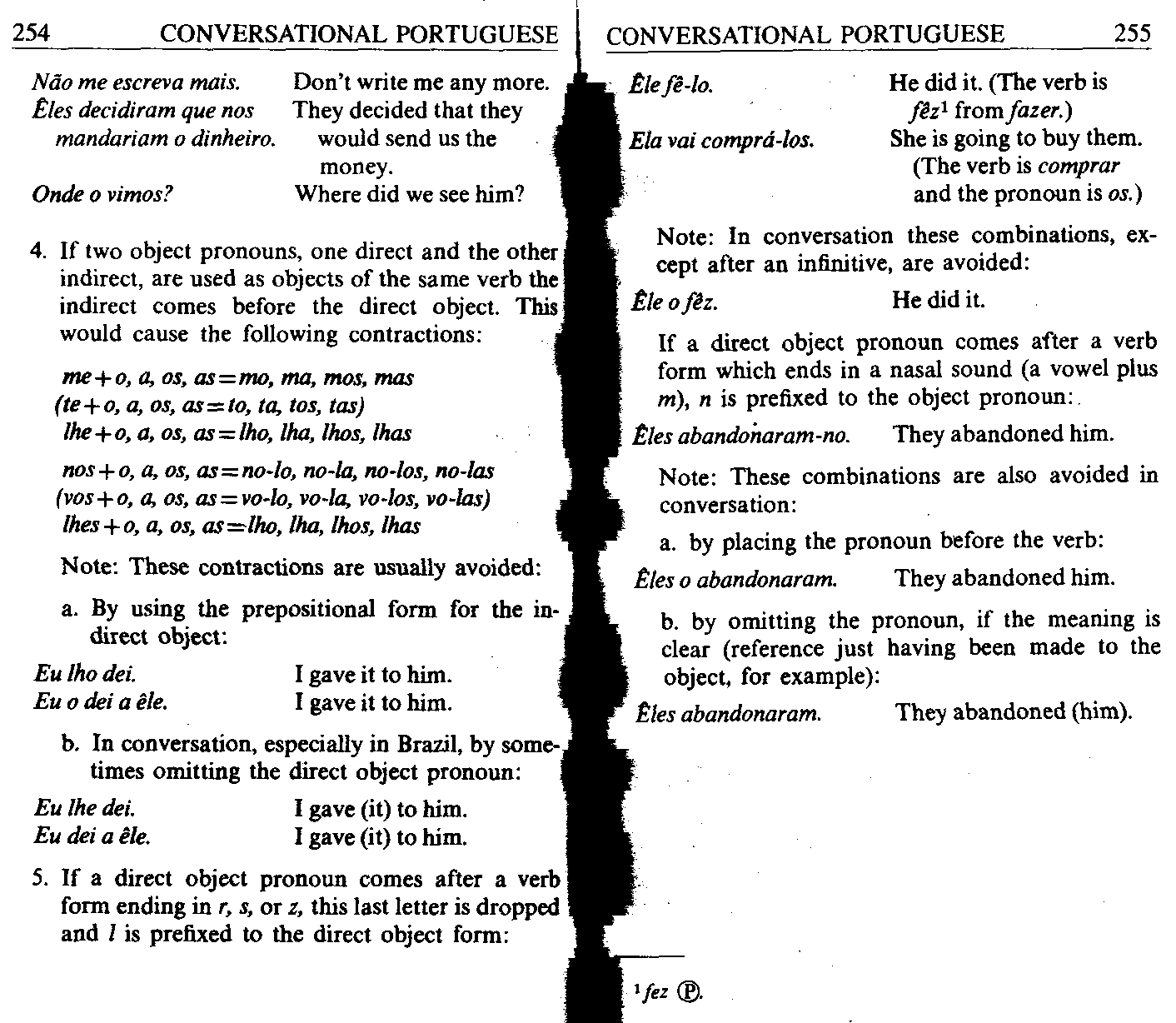Summary p254

254 CONYERSATIONAL PORTUGUESE
Nao me escreva mais. Eles decidiram que nos mandariam o dinheiro.
Onde o vimos?
Dorft write me any morę. They decided that they would send us the money.
Where did we see him?
4. If two object pronouns, one direct and the otherj indirect, are used as objects of the same verb the indirect comes before the direct object. Thisi would cause the foliowing contractions:
me+o, a, os, as=mo, ma, mos, mas (te+o, a, os, as=to, ta, tos, tas)
Ihe+o, a, os, as~iho, lim, lhos, Ihas
nos + o, a, os, as=no-lo, no~la, no-los, no-las (vos+o, a, os, as — vo-ło, vo-la, vo~los, vo-las) łhes + o, a, os, as—lho, łha, lhos, Ihas
Notę: These contractions are usualły avoided:
a. By using the prepositional form for the indirect object:
Eu lho dei. I gave it to him.
Eu o dei a ele. I gave it to him.
b. In conversation, espedally in Brazil, by some-, times omitting the direct object pronoun:
Eu Ihe dei. I gave (it) to him.
Eu dei a ele, I gave (it) to him.
5. If a direct object pronoun comes after a verb form ending in r, s, or z, this last letter is dropped and l is prefixed to the direct object form:
źle je-lo. He did it. (The verb is
fiz1 from fazer.)
Ela vai comprd-los. She is going to buy them.
(The verb is comprar and the pronoun is oj.)
Notę: In conversation these combinations, ex-cept after an infinitive, are avoided:
Źle o fiz. He did it.
If a direct object pronoun comes after a verb form which ends in a nasal sound (a vowel plus m\ n is prefixed to the object pronoun:.
Źles abandonaram-no. They abandoned him.
Notę: These combinations are also avoided in conversation:
a. by placing the pronoun before the verb:
źles o abandonaram. They abandoned him.
b. by omitting the pronoun, if the meaning is elear (reference just having been madę to the object, for example):
Źles abandonaram. They abandoned (him).
»/« ©*
Wyszukiwarka
Podobne podstrony:
Summary p272 272 CONYERSATIONAL PORTUGUESE Ela nos viu (viu-nos (j*)). Escrevi urna carta. Choveu
Summary p222 222 CONYERSATIONAL PORTUGUESE 21. Vamos_(to have dinner). a. jantar
Summary p224 224 CONYERSATIONAL PORTUGUESE (3) variations occur in different areas: a.
Summary p226 226 CONYERSATIONAL PORTUGUESH CONYERSATIONAL PORTUGUESE 227 d g g h j I I Ut m as d i
Summary p230 230 CONYERSATIONAL PORTUGUESE 3, The cedilla (cedilha) is used with
Summary p234 234 CONYERSATIONAL PORTUGUESE k. with parts of the body and articles of clothing inst
Summary p236 236 CONYERSATIONAL PORTUGUESE De and em combine with the demonstrative forms (see GS2
Summary p238 238 CONYERSATIONAL PORTUGUESE 13. MASCULINE AND FEMININE 238 CONYERSATIONAL PORTUGUES
Summary p240 240 CONYERSATIONAL PORTUGUESE 14. THE PLURAL 1. Nouns ending in a vowel, including na
Summary p242 242 CONYERSATIONAL PORTUGUESE seu can also be used to translate “his,” “her,” “their.
Summary p246 246 CONYERSATIONAL PORTUGUESE 1«. COMPAR1SON 1. Rcgular comparison facil easy ma
Summary p248 248 CONYERSATIONAL PORTUGUESE 19. PRONOUNS Pronouns have varying forms depending on w
Summary p250 250 CONYERSATIONAL PORTUGUESE CONYERSATIONAL PORTUGUESE_ 251 (te) I
Summary p256 256 CONYERSATIONAL PORTUGUESE 21. SOME CONJUNCTIONS ainda que assim que ate
Summary p258 258 CONYERSATIONAL PORTUGUESE 23. ADYERBS 1. Some Portuguese adverbs are formed by ad
Summary p260 260 CONYERSATIONAL PORTUGUESE la (acold) there (morę remote) adiante . forward,
Summary p262 262 CONYERSATIONAL PORTUGUESE sabdo soap sabonete a cake of toilet
Summary p264 264 CONYERSATIONAL PORTUGUESE Ndo ąuero este sem I don’t want this one
Summary p266 266 CONYERSATIONAL PORTUGUESE27. NEGATION 1. Ndo “not” comes before
więcej podobnych podstron